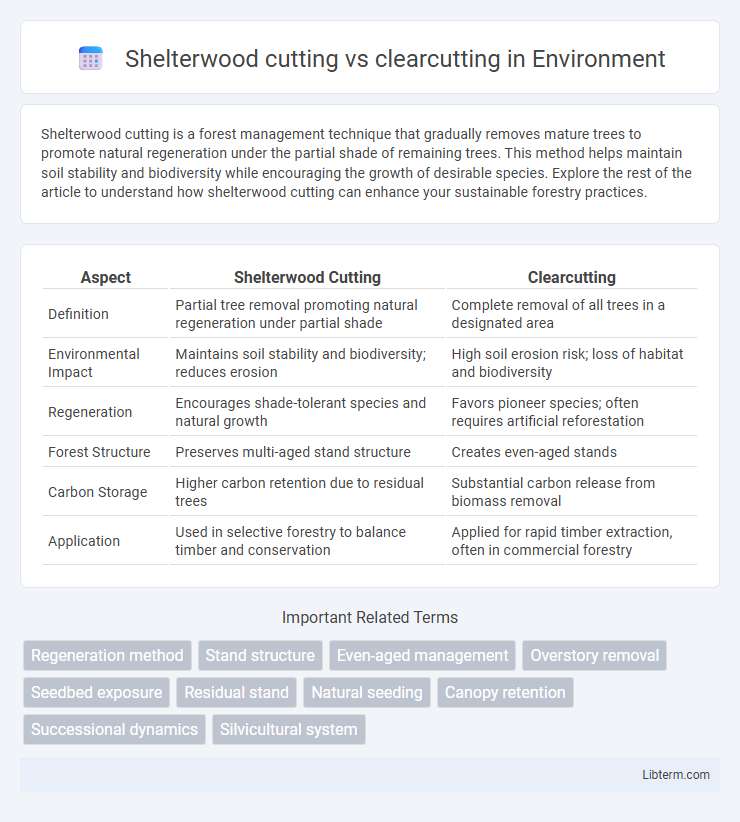Shelterwood cutting is a forest management technique that gradually removes mature trees to promote natural regeneration under the partial shade of remaining trees. This method helps maintain soil stability and biodiversity while encouraging the growth of desirable species. Explore the rest of the article to understand how shelterwood cutting can enhance your sustainable forestry practices.
Table of Comparison
| Aspect | Shelterwood Cutting | Clearcutting |
|---|---|---|
| Definition | Partial tree removal promoting natural regeneration under partial shade | Complete removal of all trees in a designated area |
| Environmental Impact | Maintains soil stability and biodiversity; reduces erosion | High soil erosion risk; loss of habitat and biodiversity |
| Regeneration | Encourages shade-tolerant species and natural growth | Favors pioneer species; often requires artificial reforestation |
| Forest Structure | Preserves multi-aged stand structure | Creates even-aged stands |
| Carbon Storage | Higher carbon retention due to residual trees | Substantial carbon release from biomass removal |
| Application | Used in selective forestry to balance timber and conservation | Applied for rapid timber extraction, often in commercial forestry |
Introduction to Shelterwood Cutting and Clearcutting
Shelterwood cutting is a forest management technique that involves the gradual removal of mature trees to promote natural regeneration under the protective canopy of remaining trees. Clearcutting, in contrast, entails the complete removal of all trees in a designated area, creating an open space for new growth but significantly altering the habitat. Both methods impact forest ecology differently, with shelterwood cutting maintaining partial cover to support biodiversity and clearcutting facilitating rapid regeneration of sun-loving species.
Defining Shelterwood Cutting
Shelterwood cutting is a forest management technique that involves the gradual removal of mature trees in several cutting phases to promote natural regeneration under the partial shade of remaining overstory trees. This method contrasts with clearcutting, which removes all trees in a single operation, resulting in an open area without canopy cover. Shelterwood cutting supports biodiversity, improves soil stability, and fosters the growth of shade-tolerant species by maintaining microclimate conditions during regeneration.
What is Clearcutting?
Clearcutting is a forestry practice that involves removing all or most trees in a designated area, creating an open space ideal for certain tree species to regenerate quickly. This method contrasts with shelterwood cutting, which retains some mature trees to provide shade and protection for young seedlings, promoting gradual forest renewal. Clearcutting can significantly impact ecosystem dynamics, affecting soil stability, wildlife habitats, and biodiversity.
Key Differences Between Shelterwood Cutting and Clearcutting
Shelterwood cutting involves the gradual removal of mature trees to promote natural regeneration under partial shade, preserving soil stability and biodiversity, whereas clearcutting entails the complete removal of all trees in an area, often leading to habitat disruption and increased erosion risk. Shelterwood cutting supports continuous forest cover and maintains microclimatic conditions beneficial for seedling establishment, while clearcutting creates open environments that may favor pioneer species but reduce species diversity. The regeneration process in shelterwood systems typically takes longer but results in uneven-aged stands, contrasting with the even-aged stands produced by the rapid and intensive clearcutting method.
Ecological Impacts of Shelterwood Cutting
Shelterwood cutting promotes biodiversity by maintaining partial canopy cover, which preserves habitat complexity and supports shade-tolerant species. This method reduces soil erosion and nutrient loss compared to clearcutting due to retained root structures and organic matter. The gradual removal of overstory trees in shelterwood cutting also facilitates natural regeneration, enhancing forest resilience and ecological stability.
Environmental Effects of Clearcutting
Clearcutting significantly disrupts ecosystems by removing nearly all trees, leading to habitat loss, soil erosion, and reduced biodiversity. This method causes increased runoff and sedimentation in nearby water bodies, negatively affecting aquatic life. In contrast, shelterwood cutting maintains partial canopy cover, preserving habitat structure and soil stability while promoting natural regeneration.
Regeneration and Forest Recovery Comparisons
Shelterwood cutting promotes natural regeneration by retaining a portion of mature trees, which provide seed sources and shade, creating favorable microclimates for young seedlings. Clearcutting removes all trees in an area, often resulting in harsher environmental conditions that may hinder natural regeneration and slow forest recovery. Studies indicate shelterwood systems support faster biodiversity restoration and more stable understory development compared to clearcut areas, where recovery can be more variable and vulnerable to erosion.
Biodiversity Considerations in Both Methods
Shelterwood cutting promotes biodiversity by maintaining partial canopy cover, which supports a variety of understory plants and wildlife habitats, fostering ecological resilience. Clearcutting often reduces biodiversity by removing all vegetation, disrupting habitats and limiting species diversity, though it can benefit sun-loving species and early successional habitats. Carefully managed shelterwood systems balance timber regeneration with biodiversity conservation, whereas clearcutting requires mitigation strategies to protect ecosystem functions and species richness.
Economic Benefits and Drawbacks
Shelterwood cutting offers economic benefits by promoting natural regeneration, potentially reducing replanting costs and maintaining a steady timber supply, which can lead to sustained long-term revenue for forest managers. In contrast, clearcutting maximizes short-term profits through rapid, large-scale timber removal but often entails higher reforestation expenses and may negatively impact future timber yields. Economic drawbacks of shelterwood cutting include slower initial financial returns and increased management complexity, while clearcutting risks soil erosion and market fluctuations affecting profitability.
Choosing the Right Harvesting Method
Shelterwood cutting promotes natural regeneration by gradually removing trees, maintaining partial canopy cover to protect seedlings and enhance biodiversity, ideal for mixed-species forests needing structural diversity. Clearcutting efficiently maximizes timber yield by removing all trees in an area, best suited for even-aged species like pine or aspen, but may increase soil erosion and reduce habitat complexity. Choosing the right harvesting method depends on forest management goals, species composition, site conditions, and long-term sustainability objectives to balance ecological impact with economic benefits.
Shelterwood cutting Infographic

 libterm.com
libterm.com